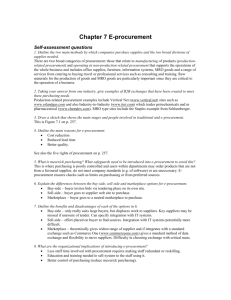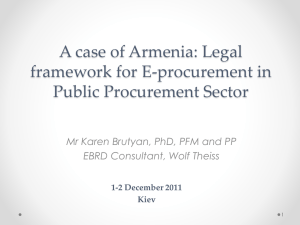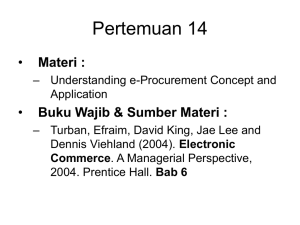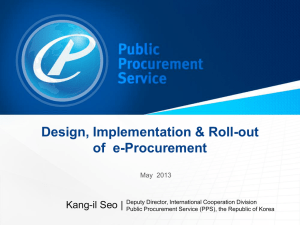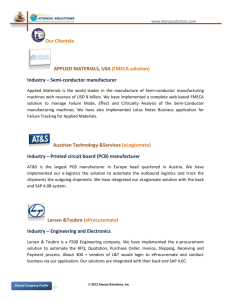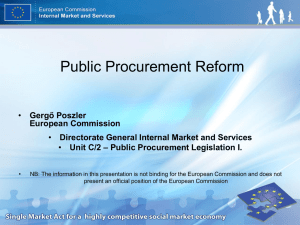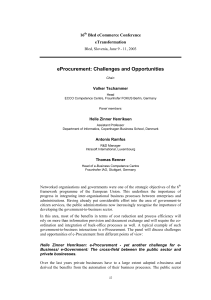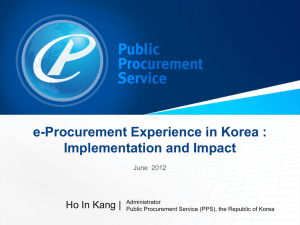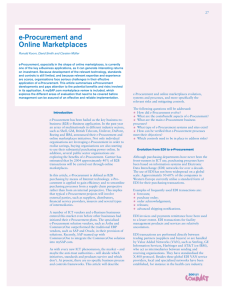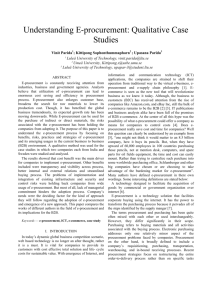Can Electronic Procurement Improve Infrastructure Provision?
advertisement
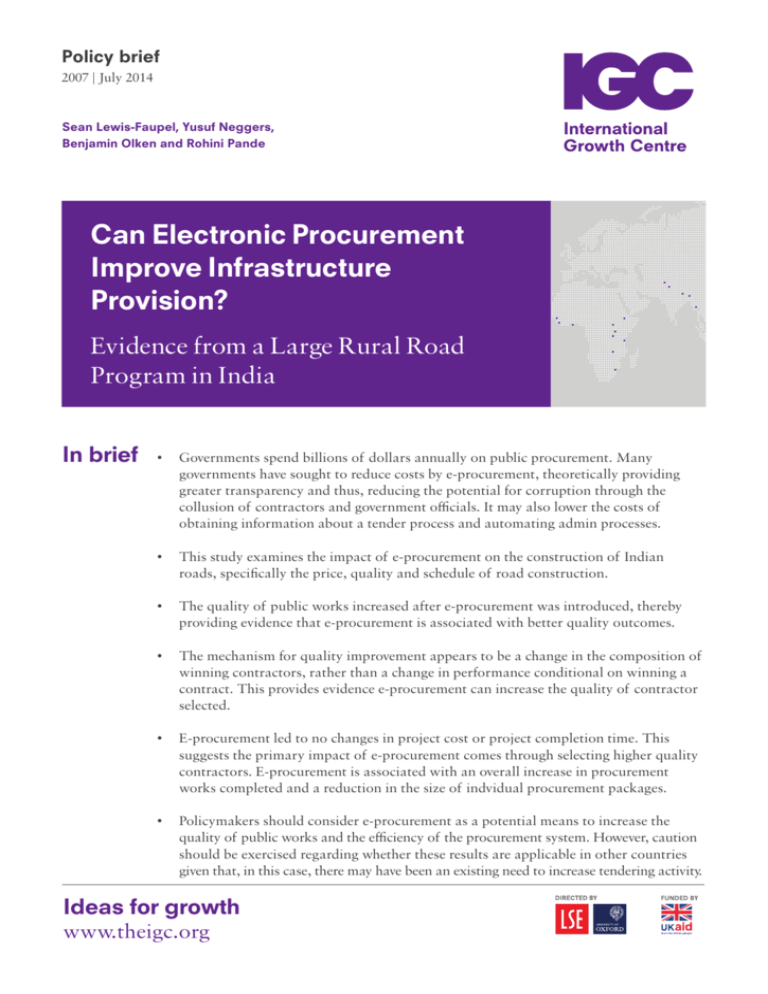
Policy brief 2007 | July 2014 Sean Lewis-Faupel, Yusuf Neggers, Benjamin Olken and Rohini Pande Can Electronic Procurement Improve Infrastructure Provision? Evidence from a Large Rural Road Program in India In brief • Governments spend billions of dollars annually on public procurement. Many governments have sought to reduce costs by e-procurement, theoretically providing greater transparency and thus, reducing the potential for corruption through the collusion of contractors and government officials. It may also lower the costs of obtaining information about a tender process and automating admin processes. • This study examines the impact of e-procurement on the construction of Indian roads, specifically the price, quality and schedule of road construction. • The quality of public works increased after e-procurement was introduced, thereby providing evidence that e-procurement is associated with better quality outcomes. • The mechanism for quality improvement appears to be a change in the composition of winning contractors, rather than a change in performance conditional on winning a contract. This provides evidence e-procurement can increase the quality of contractor selected. • E-procurement led to no changes in project cost or project completion time. This suggests the primary impact of e-procurement comes through selecting higher quality contractors. E-procurement is associated with an overall increase in procurement works completed and a reduction in the size of indvidual procurement packages. • Policymakers should consider e-procurement as a potential means to increase the quality of public works and the efficiency of the procurement system. However, caution should be exercised regarding whether these results are applicable in other countries given that, in this case, there may have been an existing need to increase tendering activity. Ideas for growth www.theigc.org Policy Motivation “This study examines the impact of e-procurement on the construction of roads in India” Governments across the world spend billions of dollars annually on public procurement. In recent years, many governments have sought to cut costs and improve infrastructure provision by utilizing systems of electronic procurement, commonly known as e-procurement. Theoretically, e-procurement provides greater transparency thereby reducing collusion among contractors and corruption among public officials. It also may increase efficiency through lowering the costs of obtaining information about a tender process and automating administrative processes. Despite the widespread enthusiasm for e-procurement, to date there is little rigorous evidence of its impact. This study examines the impact of e-procurement on the construction of roads in India, specifically examining the effect on price, quality and schedule of road construction. Policy Impact E-procurement is one of the most commonly advocated reforms to procurement systems today, with the governments of many low-income countries pursing such programs. The results of this research will help governments evaluate the benefits of switching to an e-procurement system, in addition to potentially informing governments on how to design such a system to realize such benefits. Switching to a system of e-procurement may help governments to better select the most qualified provider in addition to making better use of existing resources to increasing quality of public infrastructure. Audience and Dissemination The key decision-makers targeted by this brief are government officials engaged in the development and utilization of procurement and e-procurement systems. A more specific audience will be identified for dissemination once this research agenda is complete and a full set of policy recommendations can be made. Implications After e-procurement was introduced, the quality of public works increased “E-procurement is associated with a decrease in the likelihood that a road construction project was rated as unsatisfactory” Policy brief 2007 | The analysis provides evidence that e-procurement is associated with a decrease in the likelihood that a road construction project was rated as unsatisfactory, measured through randomly assigned quality checks. The mechanism for quality improvement appears to be a change in the composition of winning contractors, rather than a change in performance conditional on winning a contract A two-stage regression analysis revealed that the changes in quality in procurement projects was largely due to changes in which contractor is chosen rather than changes in a contractor’s activities once they are chosen. The evidence suggests that July 2014 International Growth Centre 2 e-procurement resulted in the selection of higher quality contractors. E-procurement led to no changes in project cost or project completion time “The study revealed that e-procurement is associated with a substantial increase in the total number of kilometers of roads tendered in each state in each year” The analysis suggested that there were no changes in the two other dimensions of projects that the government may care about: prices or completion time. This suggests that the primary impact of electronic procurement came through selecting higher quality contractors. E-procurement is associated with an overall increase in procurement works completed and a reduction in the size of individual procurement packages The study revealed that e-procurement is associated with a substantial increase in the total number of kilometers of roads tendered in each state in each year. After e-procurement took effect, the size of the average procurement package decreased by about 25%. Together, this suggests that e-procurement lowers the cost to the government of conducting procurement tenders. However, it also suggests that caution must be used in interpreting the results presented here to ensure that they were not due to the shifting composition of projects. Brief Summary of Research E-procurement in India has not been adopted nationally all at once but gradually rolled out at the state level. Because of this time variation across different Indian states, this study is able to separate out the impact of e-procurement from other changes occurring in the country at the same time through using a difference-indifference estimation strategy. The study focuses on a particular rural road project known as Pradhan Mantri Gram Sarak Yojana (PMGSY) that began in 2000, funded by the federal government with specific uniform criteria but executed by each state. Data was collected from PMGSY websites from 2000 to 2009 to construct a dataset covering 21 states, which includes information from over 35,000 procurement contracts. The paper evaluates bidding, costs, and quality for procurement in states/provinces before and after adoption of e-procurement, as well as those continuing under traditional procurement practices. The paper provides evidence that e-procurement is associated with an increase in tendering activity, entry of higher quality contractors, and increase in road quality. However, our analysis cannot currently distinguish between the impacts of greater tendering activity versus e-procurement on improving road quality. Ongoing work will use bidding data to attempt to distinguish the two. “Our analysis cannot currently distinguish between the impacts of greater tendering Implementation activity versus e-procurement on improv- Based on this preliminary work, policymakers should consider e-procurement as ing road quality” a potential means to increase the quality of public works and the efficiency of the public procurement system. Given that this evaluation occurred in a country which Policy brief 2007 | July 2014 International Growth Centre 3 may have had an existing need to increase tendering activity, caution should be used in assuming that the results here will be replicated in other contexts. The research team is continuing to work to provide additional evidence on the casual impact of e-procurement. This ongoing research will provide greater insight to governments and countries considering implementation of e-procurement programs. Further Readings Auriol, E. 2006. Corruption in Procurement and Public Purchase. International Journal of Industrial Organization. 24(5), 867-885. Auriol, E., T. Flochel, and S. Straub. 2008. Public procurement and Rent Seeking – The Case of Paraguay. Working paper. Bandiera, O., A. Prat, and T. Valletti. Active and Passive Waste in Government Spending: Evidence from a Policy Experiment. American Economic Review. 99(4), 1278-1308. Bobnis, G. and L.C. Fuertes. 2009. Does Exposing Corrupt Politicians Reduce Corruption? Unpublished paper, University of Toronto. Ferraz, C. and F. Finan. 2008. Exposing Corrupt Politicians: The Effect of Brazil’s Publicly Released Audits on Electoral Outcomes. Quarterly Journal of Economics. 123(2), 703- 745. Krasnokutskaya, E. and K. Seim. 2006. Bid Preference Programs and Participation Highway Procurement Auctions. Working Paper, University of Pennsylvania. Olken, B. 2007. Monitoring Corruption: Evidence from a Field Experiment in Indonesia. Journal of Political Economy. Reinikka, R. and J. Svensson. 2004. Local Capture: Evidence from a Central Government Transfer Program in Uganda. Quarterly Journal of Economics. 119(2), 679–705. Tran, A. 2008. Can Procurement Auctions Reduce Corruption? Evidence from the Internal Records of a Bribe-Paying Firm. Harvard Kennedy School job-market paper. Policy brief 2007 | July 2014 International Growth Centre 4 About the authors Sean Lewis-Faupel is a Ph.D. Candidate in Economics at the University of Wisconsin - Madison. Sean has received his MSc in Economics from the University of Wisconsin and has previous experience as a research assistant at the Harvard Kennedy School of Government. Yusuf Neggers is a Sustainability Science Fellow at the Mossavar-Rahmani Center for Business and Government at Harvard Kennedy School. Benjamin Olken is an Associate Professor of Economics in the MIT Department of Economics. He completed his Ph.D. in Economics at Harvard in 2004. He spent the 2004-2005 year as a post-doctoral fellow at the National Bureau of Economic Research, and from 2005-2008 was a Junior Fellow at the Harvard Society of Fellows. His research focuses on empirical political economy questions in developing countries, with a particular emphasis on corruption. Rohini Pande is Mohammed Kamal Professor of Public Policy at the Harvard Kennedy School of Government. Pande is an NBER Research Associate. Her research focuses on the economic analysis of the politics and consequences of different forms of redistribution, principally in developing countries. Prior to joining the Kennedy School she was an Associate Professorof Economics at Yale University. She has taught at Yale University, MIT and Columbia. She holds a PhD and MSc in Economics from the London School of Economics, an MA in Philosophy, Politics and Economics from Oxford, and a BA in Economics from St. Stephens College, Delhi University. July 2014 International Growth Centre 7 The International Growth Centre (IGC) aims to promote sustainable growth in developing countries by providing demand-led policy advice based on frontier research. Find out more about our work on our website www.theigc.org For media or communications enquiries, please contact mail@theigc.org Follow us on Twitter @the_igc International Growth Centre, London School of Economic and Political Science, Houghton Street, London WC2A 2AE Designed by soapbox.co.uk
